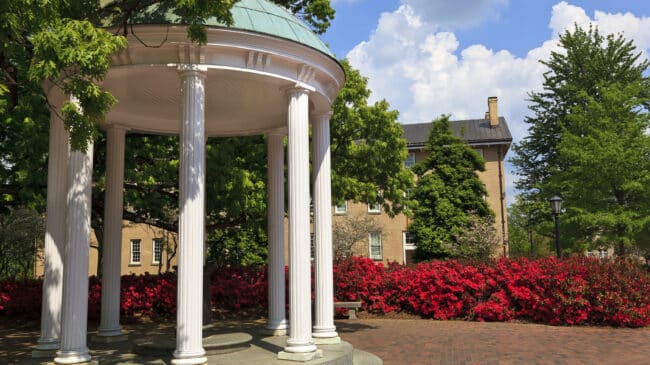In the Supreme Court of the United States
STUDENTS FOR FAIR ADMISSIONS, INC., Petitioner,
v.
UNIVERSITY OF NORTH CAROLINA, et al., Respondents.
On Petition for a Writ of Certiorari Before Judgment to the United States Court of Appeals for the Fourth Circuit
Brief Amicus Curiae of Pacific Legal Foundation, Center for Equal Opportunity, Reason Foundation, Chinese American Citizens Alliance – Greater New York, Yi Fang Chen, Coalition For Tj, and Project 21 in Support Of Petitioner
Introduction and Summary of Argument
“In the eyes of government, we are just one race here. It is American.” Adarand Constructors, Inc. v. Pena, 515 U.S. 200, 239 (1995) (Scalia, J., concurring). Both the Constitution and the Civil Rights Act of 1964 enshrine the important principle that we are equal under the law. The Equal Protection Clause prohibits the government from denying “any person . . . the equal protection of the laws.” U.S. Const. amend. XIV, cl. 1. Title VI extends that prohibition to private universities that receive federal financial assistance. See 42 U.S.C. § 2000d (“No person in the United States shall, on the ground of race . . . be subjected to discrimination under any program or activity receiving Federal financial assistance.”).
The University of North Carolina is a public institution that receives federal funds.2 See App. 144 & n.46. But in making race a factor in its admissions decisions, the University runs afoul of both Title VI of the Civil Rights Act of 1964 and the Equal Protection Clause of the Fourteenth Amendment. The protections of Title VI and the Equal Protection Clause are coextensive, Gratz v. Bollinger, 539 U.S. 244, 276 n.23 (2003), and ought to forbid racial discrimination of any kind.
Yet UNC uses race in admissions decisions. See App. 195 (UNC application readers are trained to consider “an applicant’s self-disclosed race or ethnicity” as a factor in its “holistic review” of the applicant). According to the University’s expert, race is determinative “for 1.2% for in-state students and 5.1% for out-of-state students.” App. 112.
The district court upheld this policy. The court concluded that the “small percentage of decisions” based on race was consistent with this Court’s equal protection jurisprudence. Yet the district court’s flawed decision rested upon an outlier in that jurisprudence: Grutter v. Bollinger, 539 U.S. 306 (2003).
This petition, like the petition in Students for Fair Admissions, Inc. v. President and Fellows of Harvard University, No. 20-1199, presents the ideal vehicle to overrule Grutter. See App. 188 (alleging, in Count III of Petitioner’s complaint, that UNC’s admissions process is illegal because it “uses race as a factor in admissions”); App. 189 (granting judgment on the pleadings against Plaintiff on Count III because it was foreclosed by Supreme Court precedent). From the day on which it was decided, Grutter has been “grievously wrong.” Ramos v. Louisiana, 140 S. Ct. 1390, 1414–15 (2020) (Kavanaugh, J., concurring in part). The Equal Protection Clause contains a categorical statement: government shall not “deny to any person within its jurisdiction the equal protection of the laws.” U.S. Const. amend. XIV, cl. 1. Yet the thrust of Grutter is that “not every decision influenced by race is equally objectionable.” 539 U.S. at 327. Grutter expressly endorsed racial preferences—so long as universities administer them in a “flexible, nonmechanical way.” Id. at 334. But the Equal Protection Clause and Title VI prohibit racial discrimination of any kind—flexible or rigid; mechanical or not.
Grutter’s troubles do not end there. In endorsing racial preferences in University admissions, the Grutter Court endorsed a novel interest: “obtaining the educational benefits that flow from a diverse student body.” Id. at 343; App. 184 (concluding that UNC is entitled to “judicial deference” for its decision to pursue and attain “the educational benefits of diversity”). This diversity rationale is both amorphous and unsound. It rests upon arbitrary racial classifications. The term “Hispanic,” for instance, does not describe a common background, designate a common language, or even describe gross physical appearance. See Peter Wood, Diversity: The Invention of a Concept 25 (2003). And “Asians” make up roughly 60 percent of the world’s population and encompass people of Chinese, Indian, Filipino, and many more backgrounds. David E. Bernstein, The Modern American Law of Race, 94 S. Cal. L. Rev. 171, 182–83 (2021). Although state-sponsored treatment of individuals as members of arbitrary racial groups is reason enough to overrule Grutter, the decision’s disastrous consequences provide additional support to do so. As explained below, Grutter’s diversity rationale perpetuates harmful stereotypes against Asian applicants. Grutter is also unworkable. Universities across the Nation treat the decision as an unqualified endorsement of racial preferences. Such preferences not only deny students their right to equal justice before the law, but harm the very students they purportedly benefit. See generally Richard H. Sander, A Systemic Analysis of Affirmative Action in Law Schools, 57 Stan. L. Rev. 367 (2004) (students who received racial preferences were less likely to pass the bar exam). This Court should grant the petition and overrule Grutter.
Full Amicus Brief: Students for Fair Admissions, Inc. v. University of North Carolina
